Summary
Revista Brasileira de Ginecologia e Obstetrícia. 2003;25(6):403-409
DOI 10.1590/S0100-72032003000600004
PURPOSE: to evaluate the local, regional and distant recurrence rate of a new surgical technique for the conservative treatment of the breast cancer in early stages. The technique is based on breast segmental resection with axillary dissection and skin sparing by a single periareolar incision. METHODS: one hundred and nineteen patients with breast cancer stages I and II constituted the present study. The study group comprised fifty-seven patients who were submitted to surgery by the proposed technique, while 62 patients submitted to the classic quadrantectomy constituted the control group. Postoperative radiotherapy and boost were perfomed in both groups. The average follow-up was 50.1 months for the study group and 51.2 months for the control group. The rates of recurrence, global survival and disease-free survival were analyzed and compared between the two groups. RESULTS: the rate of local recurrence in the period was 3.5% for the study group and 4.8% for the control group. There was no statistically significant difference between the groups as to disease-free survival and global survival rates. CONCLUSION: we demonstrated that the technique of segmental resection with axillary dissection by a single periareolar incision, preserving skin, did not show difference in relation to the classic quadrantectomy, regarding rates of recurrence, global survival and disease-free survival.
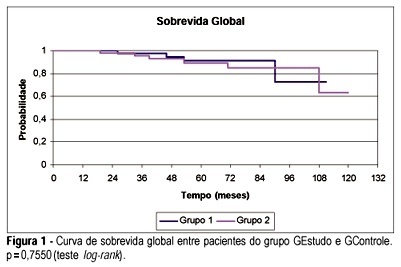
Summary
Revista Brasileira de Ginecologia e Obstetrícia. 2003;25(3):201-205
DOI 10.1590/S0100-72032003000300009
PURPOSE: to study frequency of the knowledge and practice of breast self-examination (BSE), characterizing some factors that may interfere in its practice. METHOD: during one month, 505 women, who were patients of the "Centro de Saúde Escola-Marco (Belém-Pará)", were interviewed, answering questions about the practice and knowledge on breast self-examination and associated factors. Statistical analysis was perfoprmed using the chi2 test. RESULTS: 96% of the women knew about BSE. Among these, 58.9% learned about it via the midia. However, the way that provided the most correct practice was medical orientation (37.5%). Only 21.8% of the women performed the examination monthly. The main reason for the low adhesion was unfamiliarity with the technique (48.2%). Women between 30 and 39 years presented the highest percentage of monthly practice (30.2%). The women (58.2%) who carried out the monthly examination had at least an incomplete high school degree. In 58.7% of the cases, the gynecologist did not stimulate the practice of the BSE. CONCLUSIONS: although BSE is known by practically all the interviewees, more than one third of them do not practice it. The main reason of the low adhesion was the unfamiliarity with the technique. Level of instruction and age of the women interfered in the practice of BSE, but presence of breast cancer cases in the family did not.
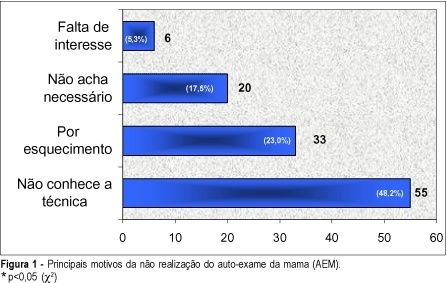
Summary
Revista Brasileira de Ginecologia e Obstetrícia. 2001;23(4):205-208
DOI 10.1590/S0100-72032001000400002
Purpose: to evaluate the rate of lymphedema and its relation to the type of surgery, age and weight of the patient. Methods: one hundred and nine patients with breast cancer, submitted to modified radical mastectomy sparing the pectoralis major or both pectorales, were studied. Differences of more than 2.0 cm between the diameters of the upper members, measured above and below the elbow, were considered as due to lymphedema. Results: a total rate of 14% of this complication was observed (15 cases). In mastectomies sparing both pectoralis muscles, a smaller rate was observed (9%), when compared to 15% using Patey's technique. However, the difference was not significant. There was a significant relationship between the incidence of lymphedema and the patient's weight and age. The lymphedema was observed in only one of the 34 patients younger than 46 years old, and none of the 19 patients with up to 50 kg presented lymphedema. Conclusion: in the present series lymphedema of the upper limb was associated with the older and heavier patients.
Summary
Revista Brasileira de Ginecologia e Obstetrícia. 2001;23(4):255-258
DOI 10.1590/S0100-72032001000400009
We report a malignant case of breast neoplasm, with the diagnosis of leiomyosarcoma. This rare neoplasm has a less aggressive biological behavior than the other types of breast sarcomas. That is the reason why we emphasize the correct diagnosis, and the necessity of graduating the neoplasm, for the patient's best follow-up. In our case, after 2 years of follow-up the patient continued with no relapse of the disease.
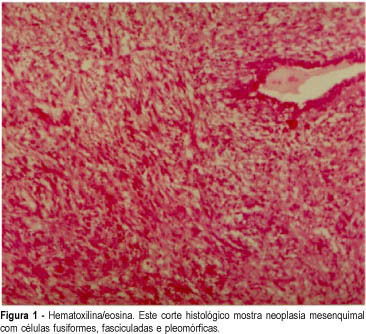
Summary
Revista Brasileira de Ginecologia e Obstetrícia. 2002;24(8):535-539
DOI 10.1590/S0100-72032002000800006
Purpose: to study the association between long-standing type 1 diabetes with bad glycemic control and breast inflammatory lesions which can simulate inflammatory carcinoma. Patients and Methods: eighteen patients were studied, retrospectively, in a mastology reference center from January 1998 to December 2001, presenting with breast inflammatory lesion with or without palpable mass. They were submitted to serum glucose and glycosylated hemoglobin determination, as well as image examination and histopathologic analysis, and diabetic mastopathy was diagnosed. Results: the patients' average age was 50.2 years, and all had insulin-dependent diabetes mellitus, with average disease time of 14.9 years. All patients, with no exception, had a bad glycemic control; the average blood glucose was 329.6 mg/dL and the glycosilated hemoglobin average was 9.7%. NPH insulin dose being applied per day was 37.2 units. Patients underwent a clinical treatment with antibiotics and control of the glycemic levels with NPH insulin and had resolution of the symptoms in about five weeks. Conclusion: the professionals involved in women health care must be aware of this inflammatory pathology of the breast and its benign characteristics to avoid unnecessary procedures sometimes with patient injury.
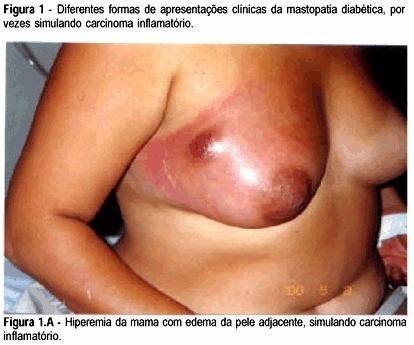
Summary
Revista Brasileira de Ginecologia e Obstetrícia. 2002;24(4):233-239
DOI 10.1590/S0100-72032002000400004
Purpose: to analyze sensitivity, specificity, positive and negative predictive values and the likelihood ratio of transvaginal ultrasound and hysteroscopy when compared with the histopathologic examination of the endometrium in women with breast cancer who have been treated with tamoxifen. Methods: transversal study with 30 women in whom transvaginal ultrasound evaluated the echogenic pattern of endometrial echo and its thickness. Hyteroscopy was performed and described as normal (normal or atrophic endometrium) or abnormal (thickening, polyps, leiomyoma, synechia). Material for histopathology was obtained from endometrial biopsy and the findings were considered normal (irregular endometrial maturation and/or atrophy) or abnormal (polyps, simple or complex hyperplasia, leiomyoma or endometrial carcinoma). Results: the general diagnosis of endometrial modifications was present in 36.6% of patients. The most frequent results were cystic atrophy (46.6%) and endometrial polyps (26.6%). Through the ROC curve the best cutoff of 8 mm of endometrial thickness measure was determined. This measure showed sensitivity of 72.7%, specificity of 72.9%, positive predictive value of 66.6%, negative predictive value of 83.3% and likelihood ratio of 3.4. Hysteroscopy showed sensitivity of 90.9%, specificity of 68.4%, positive predictive value of 62.5%, negative prediction value of 92.8% and likelihood ratio of 2.8. Conclusions: the most frequent endometrial modifications were cystic atrophy followed by polyps. Transvaginal ultrasound showed a higher rate of false-positive (42.1%), when the cutoff for the thickness of the endometrium was 5 mm; however acuracy improved when the measure of 8 mm was used. The cutoff of 8 mm was determined through the ROC curve.
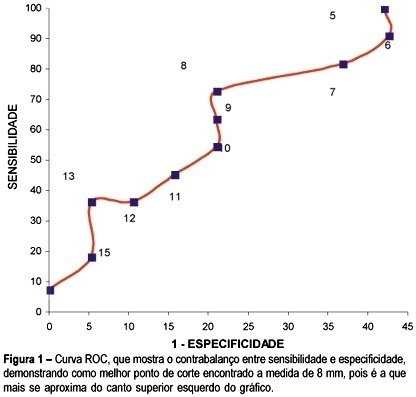
Summary
Revista Brasileira de Ginecologia e Obstetrícia. 2002;24(4):221-226
DOI 10.1590/S0100-72032002000400002
Purpose: to evaluate the relationdhip between preservation of the intercostobrachial nerve and pain sensitivity of the arm, total time of the surgery, and number of dissected nodes in patients submitted to axillary lymphadenectomy due to breast cancer. Methods: an intervention, prospective, randomized and double-blind study was performed on 85 patients assisted at the State University of Campinas, Brazil, from January 1999 to July 2000. The patients were divided into two groups, according to the intention of preserving or not the intercostobrachial nerve. The surgeries were performed by the same researchers, utilizing the same technique. The postoperative evaluations were performed within 2 days, 40 days and after 3 months. The pain sensitivity of the arm was evaluated through a specific questionnaire (subjective evaluation) and through a neurological physical examination (objective evaluation). Results: the surgical technique was applied to all patients and the preservation of the intercostobrachial nerve was related to a significant decrease in the alterations of pain sensitivity of the arm, both by the subjective and objective evaluations. After three months, in the subjective evaluation, 61% of the patients were asymptomatic in the intercostobrachial nerve preservation group and 28.6% in the nerve section group (p<0.01). By the objective evaluation, 53.7% of the patients presented normal neurological examination in the intercostobrachial nerve preservation group and 16.7% in the nerve section group (p<0.01). No significant difference was observed regarding total time of surgery (p=0.76) and number of dissected nodes between the two evaluated groups (p=0.59). Conclusions: these data show that the preservation of the intercostobrachial nerve is feasible and leads to a significant decrease in the alterations of pain sensitivity of the arm, without interfering in the total time of surgery and the number of dissected nodes.